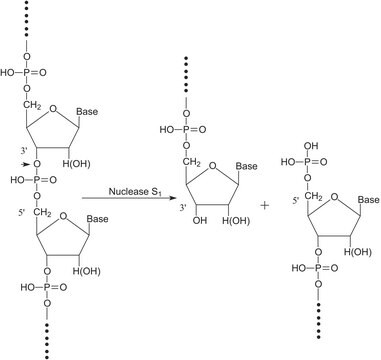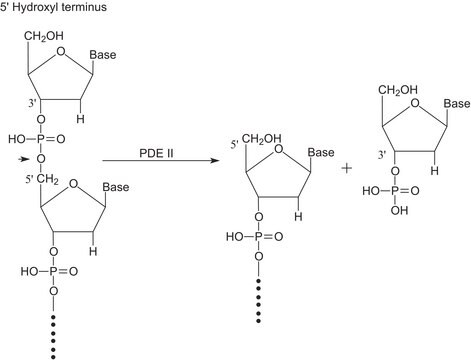N8630
Nuclease P1 from Penicillium citrinum
lyophilized powder, ≥200 units/mg protein (E1%/280, 3′-5′-Phosphodiesterase)
Synonym(s):
3′-Phosphohydrolase, Nuclease 5′-Nucleotidehydrolase, Endonuclease P1
About This Item
Recommended Products
biological source
Penicillium citrinum
Quality Level
form
lyophilized powder
specific activity
≥200 units/mg protein (E1%/280, 3′-5′-Phosphodiesterase)
secondary activity
≥1,000 units/mg protein 3′-nucleotidase
mol wt
42-50 kDa
packaging
vial of ≥250 units (using RNA substrate)
technique(s)
DNA extraction: suitable
DNA purification: suitable
suitability
suitable for molecular biology
application(s)
cell analysis
storage temp.
2-8°C
Looking for similar products? Visit Product Comparison Guide
General description
Nuclease P1 from Penicillium citrinum is a zinc-dependent endonuclease that exhibits increased activity in the presence of low concentrations of urea. Nuclease P1 selective activity has found useful applications in studies on nucleic acid structure.
Application
- Nuclease P1 cleave of single stranded DNA or RNA to 5′ mononucleotides
- Nuclease P1 supports DNA damage and modification research
- Nucleic acids base composition and structural analysis can be done by Nuclease P1
- Nuclease P1 has historically been used for the industrial production of 5′-mononucleotides from yeast RNA.
- Removal of nucleic acids through protein purification can be done by Nuclease P1
- Nuclease P1 is a key reagent for the development of methods for studies involving t-RNA dependent amino acid biosynthesis and t-RNA dependent trans-amidation
- Nuclease P1 from Penicillium citrinum has been used in a study to assess crystal structures using ammonium sulphate or polyethylene glycol 4000 as a precipitating agent.
- Nuclease P1 was used in a study to investigate a method for the direct sequence analysis 20-25 nucleotides from the terinini of 5′ or 3′ end group labeled RNA.
- Nuclease P1 is used to improve the sensitivity of a 32P-labeling method for the detection of DNA adducts.
Biochem/physiol Actions
Features and Benefits
Physical properties
Unit Definition
3′-Nucleotidase: One unit will hydrolyze 1.0 μmole of orthophosphate from 3′-AMP per min at pH 7.2 at 37 °C.
signalword
Danger
hcodes
pcodes
Hazard Classifications
Resp. Sens. 1
Storage Class
11 - Combustible Solids
wgk_germany
WGK 3
flash_point_f
Not applicable
flash_point_c
Not applicable
ppe
Eyeshields, Gloves, type N95 (US)
Certificates of Analysis (COA)
Search for Certificates of Analysis (COA) by entering the products Lot/Batch Number. Lot and Batch Numbers can be found on a product’s label following the words ‘Lot’ or ‘Batch’.
Already Own This Product?
Find documentation for the products that you have recently purchased in the Document Library.
Customers Also Viewed
Our team of scientists has experience in all areas of research including Life Science, Material Science, Chemical Synthesis, Chromatography, Analytical and many others.
Contact Technical Service









